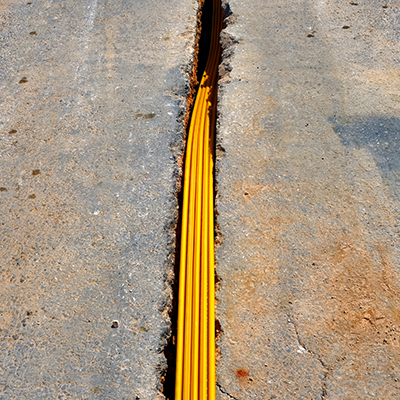As networks ramp up support for 5G, cloud and the internet of things (IoT), a growing number of distributed applications are being deployed to service the deluge of data being generated at the edge. In response, the traditional centralized data center model is evolving toward a more edge-first distributed paradigm, playing to the strengths of the multi-tenant data center (MTDC).
Flexible by design, MTDCs specialize in providing configurable, high quality white space, agile networking designs and cross-connections to different cloud and service providers. Yet, the rapid rise in edge-to-core traffic is driving the need for higher-bandwidths, beginning with data center interconnects (DCIs).
Conduit capacity, set in stone
The MTDC DCI network represents a recurring revenue stream, no different than the power, services, and white space they provide to tenants and incoming service providers. The more fiber they can pull through conduit, the more recurring revenue they can achieve; however, the challenge is that the available capacity inside the duct is quite literally set in stone, encased in concrete within the trench.
In a typical MTDC installation, the most common inner diameters of DCI conduit being deployed is either 1¼ inch, 2 inches or 4 inches, as BICSI suggests a fill ratio of no more than 70 percent. Most installations today prefer to err on the side of caution and adhere to a 50-percent fill rate. Thus, using a typical 288-fiber loose tube cable, a data center can fit 33 cables—9,504 fibers—into a 4-inch (I/D) conduit. However, bandwidth demands are pushing the limits of traditional 288-fiber cable. Many MTDC facilities are now transitioning to 864-fiber and 1,728-fiber cables, quickly maxing out the capacity of their DCI conduits.
Increasing the duct capacity is virtually impossible without significant costs. Therefore, to increase DCI fiber counts (and meet rising revenue requirements) MTDCs must find ways to fit more fibers into their existing conduits.
Rollable ribbon fiber cable
A new method for making fiber cables has emerged which dramatically reduces the overall diameter of the fiber cable, enabling MTDCs to safely pack twice as many fibers into a standard conduit compared to the traditional loose buffer tube cabling.
Rollable ribbon fiber cable is based, in part, on the earlier development of the central tube matrix ribbon cable which featured ribbon stacks of up to 864 fibers within a single, central buffer tube. The fibers are grouped and continuously bonded down the length of the cable which increases its rigidity. While this affects little when deploying the cable in an OSP application in a data center a rigid cable is undesirable because of the limited routing restrictions these cables require.
In the rollable ribbon fiber cable, the fibers are attached intermittently to form a loose web. This configuration makes the ribbon more flexible, allowing the fibers to flex with a degree of independence to one another. The fibers can now be “rolled” into a cylinder, making much better use of space when compared with flat ribbons. As many as six 3,456 rollable ribbon fiber cables can be loaded into one four-inch duct, more than twice the density of conventionally packed fibers.
The intermittently bonded web structure also reduces the bend radius, making these cables easier to work with inside the tighter confines of the data center. Inside the cable, rollable ribbon fiber takes on the physical characteristics of loose fiber, easily flexing and bending to increase routing in tight spaces. In addition, rollable ribbon fiber cabling uses a completely gel-free design which helps reduce the time required to prepare for splicing, therefore reducing labor costs.
Faster splicing and pre-provisioning
The new, higher-capacity fiber design also has at least one more trick up its sleeve. The intermittent bonding maintains the fibers’ alignment and reduces the distance between the first and last fiber in the row. This enables installers to position the fibers naturally into a smaller cross-section making it perfect for splicing. All fibers can now be placed quickly into a mass fusion splicer, rather than having to splice each fiber individually. 12 ribbon fibers can be spliced in the same amount of time that it takes to splice a single stranded fiber. This becomes more important as MTDCs work to keep up with the increased number links between customer halls that must be pre-provisioned.
Market demand is growing
As fiber counts in the data center rise, rollable ribbon is becoming more common across the DC ecosystem. This includes the customer types that MTDCs must interface with, such as hyperscale and cloud data centers, and service providers. Specifically, three key applications have emerged:
- Urban DC interconnects requiring very-high fiber counts and frequent access
- Long-distance network builds where blowing performance is important
- Networks requiring a high fiber count cable that is suited for congested routing paths with tight bends
Yet, some DC owners are still a little behind the curve when it comes to awareness of rollable ribbon fiber technology, and how and when to deploy it; however, MTDCs are in a unique position to benefit. As more data is created and consumed at the edge, hyperscalers and cloud-based DCs are increasingly looking to edge-based MTDCs to help service that traffic. Rollable ribbon fiber cable enables MTDC network managers to support the current and emerging bandwidth needs of their hyperscale and cloud customers, while maximizing the revenue potential of their DCI ducting. The upshot is that more customer and service provider links into the MTDC can be added, leading to more additional monthly billing opportunities for the MTDC.
For more information on rollable ribbon fiber technology, download CommScope Single-mode Rollable Ribbon Ordering Guide for MTDCs, or check out CommScope’s cable conduit calculator to see how you can maximize your fiber capacity and revenues.
















